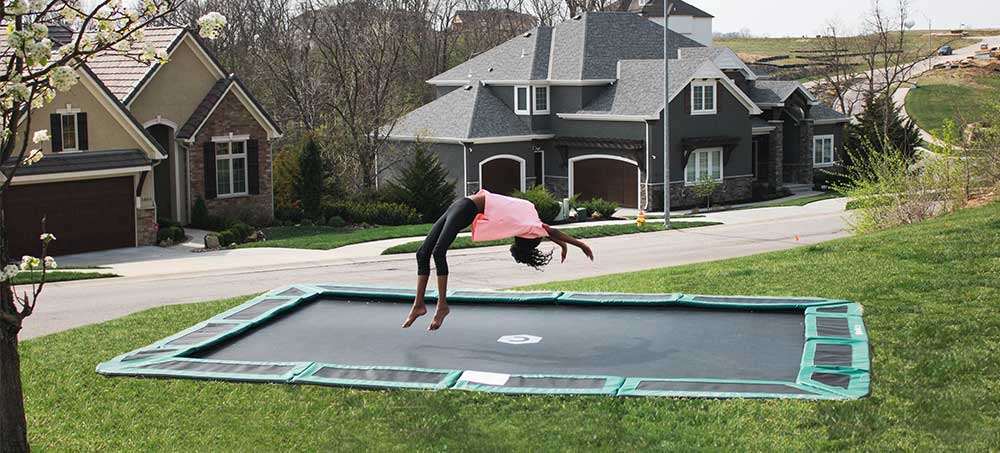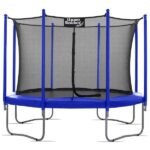To install a trampoline on a slope or uneven ground, level the area first or use adjustable legs. Ensure the ground is stable to prevent accidents.
Jumping into the excitement of backyard fun requires a stable and secure environment, especially when setting up a trampoline. Dealing with a slope or uneven ground can be challenging, but with the right approach, your trampoline can be a safe source of entertainment.
Proper installation is crucial to avoid any tilting that could lead to injuries or damage to the trampoline itself. Finding a flat surface is ideal; if that’s not available, leveling the ground or using equipment designed for uneven terrain is essential. This introduction sets the stage for homeowners to understand the importance of careful installation for safety and durability under less than perfect conditions.
Introduction To Trampoline Installation
Jumping into trampoline setup is more than just piecing together frames and springs. A solid foundation is vital for safety and performance. This section provides guidance for those preparing to install a trampoline on sloped terrain or uneven ground.
Challenges Of Sloped Terrain
Sloping grounds present unique obstacles in trampoline assembly. Here are common challenges:
- Unequal leg heights cause instability.
- Increased risk of injury due to unbalanced surfaces.
- Additional groundwork may be necessary to level the area.
Benefits Of A Properly Installed Trampoline
Optimal bounce performance and safety are the rewards of a well-installed trampoline. A level setup minimizes risks and boosts enjoyment. Benefits include:
- Enhanced safety for users.
- Extended equipment lifespan due to even wear.
- Better trampoline stability and performance.
Follow these insights for a successful trampoline installation, making bouncing a joyous and safe activity for everyone involved.

Credit: www.capitalplay.com
Pre-installation Planning
Setting up a trampoline promises endless fun. But, it does require careful planning, especially on uneven ground. Let’s dive into how to prepare for trampoline installation on a slope.
Evaluating The Slope
Before anything, assess the area. Use a level tool to determine the angle of the slope. Small inclines can often be worked with. A slope over 1 foot may need leveling.
Tools And Materials Needed
- Spirit level
- Measuring tape
- Shovel – for excavation
- Tamper – to flatten the soil
- Landscape fabric – optional for weed control
Collect these tools to ensure a smooth installation.
Levelling Techniques
Levelling Techniques for trampoline installation on uneven ground are vital to ensure safety and functionality. Proper installation starts with a flat, stable surface, so let’s explore effective methods to create a level area for your trampoline on a slope or uneven ground.
Cut And Fill Method
The cut and fill method is a straightforward levelling technique. It involves cutting soil from the higher part of the slope and using it to fill in the lower areas.
- Identify the high and low spots on the ground.
- Remove soil from elevated sections.
- Compact the soil in lower areas for stability.
- Ensure the ground is level using a spirit level.
This method ensures your trampoline sits on a level base without wobbling or tipping over.
Using Retaining Walls
Retaining walls serve as a robust solution for levelling. They prevent soil erosion and provide a flat surface for your trampoline.
- Measure the height difference across the slope.
- Construct a retaining wall at the base of the slope.
- Backfill the area between the slope and the wall with soil.
- Compact the backfill to eliminate any air gaps.
Retaining walls ensure a permanent, level area and add aesthetic appeal to your yard.

Credit: m.youtube.com
Assembling The Trampoline
Setting up a trampoline on a slope or uneven ground starts with careful assembly. The right assembly ensures safety and longevity of the trampoline. Let’s dive into the essential steps for putting it together.
Step-by-step Frame Assembly
Begin by sorting all pieces. Lay them out on a flat surface. This makes identification easier. Follow these steps:
- Connect the frame pieces. Start with the base, forming a circle or rectangle, depending on your trampoline’s shape.
- Ensure each connection is tight. Use any provided tools or your own if necessary.
- Check for stability. Push gently against the frame. It should not wobble or make noises.
- As slopes require extra care, use leveling blocks or soil to create a flat surface under the frame legs where needed.
Attaching The Mat And Springs Securely
Once your frame stands firm, it’s time to attach the mat and springs. This part is crucial:
- Hook one spring into the mat’s V-ring, then pull it to connect to the frame.
- Go to the opposite side and attach the next spring. This keeps the tension even.
- Continue this process, forming an “X” pattern across the trampoline.
- Double-check each spring. They must be hooked properly for optimal tension and safety.
- Use a spring pulling tool to avoid injury and ensure a snug fit.
Finishing the assembly right ensures endless fun on your new trampoline. Ensure safety by double-checking every component. Now, let the jumping begin!
Safety Considerations
Setting up a trampoline on uneven ground demands extra attention to safety. Proper installation can prevent accidents and ensure lasting fun. Let’s discuss how to avoid risks with correct positioning and regular checks.
Positioning Away From Hazards
Choose the trampoline’s spot wisely. Look for a level area, and if one isn’t available, consider landscaping to create a flat space. Here are important points:
- Keep a safe distance from fences, trees, and other structures.
- Ensure ample space surrounds the trampoline.
- Consider sunlight direction. Position to avoid direct glare.
- Use stakes or anchors for added stability.
Regular Maintenance Checks
Consistent upkeep is vital. It can protect users from unexpected equipment failure. Follow these tips:
| Check | Frequency | Details |
|---|---|---|
| Frame | Monthly | Examine for rust or wear. |
| Springs | Monthly | Ensure tight and intact. |
| Mat | Bi-weekly | Check for holes or tears. |
| Net | Bi-weekly | Look for fraying or damage. |
Record maintenance tasks. Replace parts as needed. Always inspect the trampoline before use.
Final Touches
Now that the trampoline is assembled, it’s time for the final touches. These steps ensure the trampoline’s safety and visual appeal. Careful attention to stabilization and aesthetics provides peace of mind and a fun-filled bounce for all.
Stabilizing With Anchors
Securing the trampoline on a slope requires sturdy anchors. Follow these steps:
- Choose high-quality anchors designed for trampolines.
- Twist or hammer the anchors into the ground at each leg of the trampoline.
- Ensure that each anchor is equally tightened for consistent stability.
- Attach the straps from the anchors to the trampoline frame.
- Check the tension regularly to maintain safety.
Landscape Integration And Aesthetics
A trampoline should blend with your yard. Consider these tips:
- Use decorative plants or mulch around the trampoline base.
- Position it near natural slopes for a seamless look.
- Install a safety net that complements your garden’s style.
- Maintain easy access with a clear path to the trampoline.

Credit: www.reddit.com
Frequently Asked Questions On How To Install A Trampoline On A Slope Or Uneven Ground
Can You Install A Trampoline On A Slope?
Installing a trampoline on a slope is possible, but requires leveling the area. You can use retaining walls or soil to create a flat surface. It’s crucial for safety and the trampoline’s functionality. Additionally, secure it well to prevent movement or tipping over.
What’s Needed For Setting Up A Trampoline On Uneven Ground?
For uneven ground, use leveling blocks or dig into the slope to create a flat area. Ensure you have a spirit level, shovel, and potentially sand or gravel to aid in the process. Always double-check the stability before use to ensure safety.
How To Secure A Trampoline On Sloped Ground?
To secure a trampoline on sloped ground, anchor it with U-shaped wind stakes or anchor kits. These go deep into the soil, providing stability. It prevents the trampoline from moving during use or in windy conditions, which is essential for preventing accidents.
Is Special Equipment Required For Uneven Ground Trampoline Setup?
Special equipment isn’t always necessary, but things like a spirit level, shovel, and landscaping tools can help. For more significant slopes, you might need retaining wall materials or leveling blocks for support and safety.
Conclusion
Installing your trampoline on a slope or uneven ground doesn’t have to be a challenge. By following the step-by-step guide provided, you can ensure a safe and level playing surface. Remember, patience and precision are key to successfully transforming a sloped area into the perfect spot for your trampoline.
Happy bouncing!


